Outcomes after Declining Increased Infectious Risk Kidney Offers for Pediatric Candidates in the United States
Johns Hopkins University, Baltimore, MD
Meeting: 2019 American Transplant Congress
Abstract number: B136
Keywords: Kidney transplantation, Pediatric
Session Information
Session Name: Poster Session B: Kidney Donor Selection / Management Issues
Session Type: Poster Session
Date: Sunday, June 2, 2019
Session Time: 6:00pm-7:00pm
 Presentation Time: 6:00pm-7:00pm
Presentation Time: 6:00pm-7:00pm
Location: Hall C & D
*Purpose: Kidneys from donors at increased infectious risk for disease transmission (IRDs) confer substantial survival benefit in adults, yet the impact of IRDs in pediatric candidates remains unclear in the context of high waitlist prioritization.
*Methods: Using 2010-2016 SRTR data, we studied 2,417 pediatric candidates (age<18) who were offered an IRD kidney that was eventually used for transplantation. We followed candidates from date of first IRD offer until date-of-death or censorship and used Cox regression to estimate mortality risk associated with IRD acceptance adjusting for age, sex, race, diagnosis, and dialysis time.
*Results: Over the study period, 2250 (93.1%) pediatric candidates declined and 286 (11.8%) accepted an IRD offer; 119 (41.6%) of the 286 had previously declined a different IRD. Cumulative survival among those who accepted versus declined the IRD was 99.6% vs 99.4% 1yr and 96.6% vs 97.6% 5yrs post-decision (p=0.4, Figure 1). Unlike the substantial survival benefit seen in adults (adjusted HR=0.52), pediatric candidates who accepted IRDs experienced similar survival when compared to those who declined (aHR=0.621.383.09, p=0.4). Six years after their initial IRD offer decline, 68.4% of pediatric candidates had received a non-IRD DDKT, 13.0% had received an LDKT, 6.9% had received a different IRD DDKT, 1.3% had died on the waitlist, 8.0% had been removed from the waitlist, and 2.3% were still waiting (Figure 2). Those who declined IRDs waited a median 9.5 months for a non-IRD kidney transplant (11.5 months among those <6yrs, 8.8 months among those on dialysis). KDPI of the eventually accepted non-IRD kidneys (median=13, IQR=6-23) was similar to KDPI of the declined IRDs (median=16, IQR=9-28).
*Conclusions: Unlike in adults, IRDs conferred no survival benefit to pediatric candidates, although those who declined IRDs extended their waiting times by almost a year. The decision to accept IRD kidneys should balance the advantage of faster transplantation against the risk of infectious transmission.
To cite this abstract in AMA style:
Bowring M, Jackson K, Wasik H, Neu A, Garonzik-Wang J, Durand C, Desai N, Massie A, Segev D. Outcomes after Declining Increased Infectious Risk Kidney Offers for Pediatric Candidates in the United States [abstract]. Am J Transplant. 2019; 19 (suppl 3). https://atcmeetingabstracts.com/abstract/outcomes-after-declining-increased-infectious-risk-kidney-offers-for-pediatric-candidates-in-the-united-states/. Accessed December 20, 2025.« Back to 2019 American Transplant Congress


